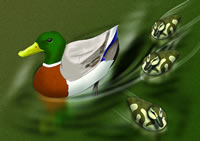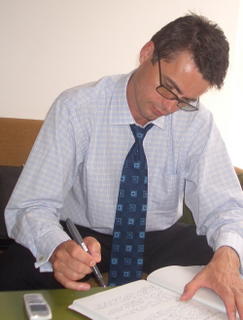Wild kids

Mallards were introduced into Australia from the Northern Hemisphere and have been breeding with our native Pacific Black Duck.
Common name: Mallard Scientific name: Anas platyrhynchos Photo: A. Skates
Mallard
Mallards are ducks that live near ponds, lakes and dams on urban and rural land in south-eastern Australia. The males have a green head, yellow beak and chestnut coloured breast. The females are brown all over. They both have flat beaks with thin plates to sieve food particles out of the water. They have feet with three webbed toes and one very small back toe.
Mallards call with a loud quack.
 This is a male Mallard swimming with some ducklings.
This is a male Mallard swimming with some ducklings.Mallards look for small plants and animals in the water. They use their beak to feel around in the muddy bottom of ponds, lakes and dams for food. On land they look for seeds, flowers, food scraps and insects in the morning and late afternoon.
Mallards make nests from a scrape on the ground lined with a small amount of grass. The female lays eight to twelve glossy, light green eggs that she sits on for 26 to 28 days. When the eggs hatch the ducklings are covered in soft down. They follow their parents to water within a day of hatching and can swim as soon as they reach water. The ducklings can feed themselves shortly after hatching and have feathers and are ready to fly in seven to eight weeks.
Copyright © Australian Museum, 2003

No comments:
Post a Comment